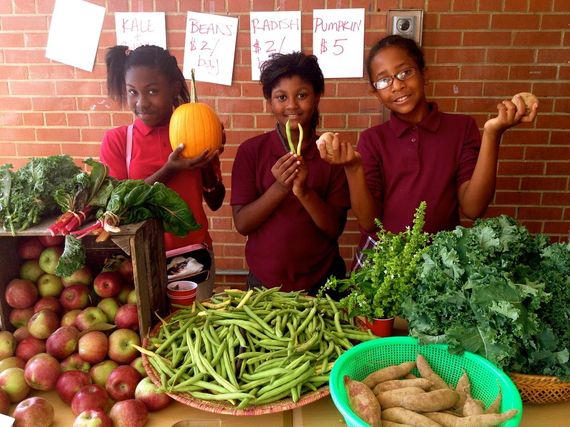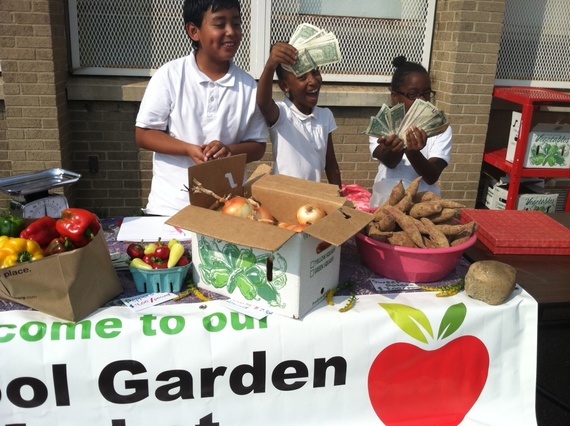This is a strange and inconsistent moment for school food in the U.S. At the same time that we are arguing for healthier meals in the cafeterias, we also have a long-standing tradition of turning our school kids into candy pushers in order to raise funds for their team uniforms or their band trips. We bemoan the national obesity rates, and then set up tables loaded with rice crispy treats, cupcakes, and brownies in the entrances of our schools.
What we're learning in D.C. is that it doesn't have to be like this. Schools can be healthy food access points within their communities. Kids can raise money pushing carrots instead of candy corn.
In the fall of 2013, DC Greens piloted a School Garden Market program at six K-12 schools across the city. Similar to a farm stand, a School Garden Market is run by the school's youth, stocked with produce from their garden, and supplemented with offerings from a local farm. The farmer that we worked with (Mike Nolan of Earth Spring Farm) provided produce at wholesale prices, allowing the kids to mark it up as they see fit. His farm has an online ordering system, so each week the students had to make key decisions about inventory and market interests.
Once a week throughout the fall, school dismissal turned into an open-air market, with entrepreneurial 7th graders luring classmates over with samples of local apples, and time-strapped parents picking up groceries while they picked up their children. Thanks to support from the USDA, we were able to provide SNAP (food stamp) terminals to each school, allowing them to accept federal benefits. In the first season, all markets turned a profit (totaling more than $4,500) and sold more than 3,000 lbs. of produce to their communities.
The benefits of this program abound:
- Students gain hands-on math and marketing skills while running the farm stand;
- Students are transformed into healthy food ambassadors within their communities, prideful of the produce that they have grown;
- By meeting families where they are and providing SNAP machines to the farm stands, schools become much-needed food access points for low-income residents;
- Proceeds from the school garden markets circle directly back into the school garden program, creating a closed-loop and building sustainability; and
- The program creates new markets for local farmers to sell their fresh produce.
This spring, the D.C. program added three more schools, and we plan to keep expanding until every school in the District has a farm stand run by students. This is a simple idea that aligns with our national interests. It's an idea whose time has come. And we are not alone - Denver's been running their Youth Farmers' Market program since 2008, and others across the country are following suit. The movement is growing. One need only look at the excitement surrounding the release of the documentary FED UP and the recent rally to protect heightened nutrition standards in our school meals. We all want better solutions for our kids.
Watch out bake sale. We're coming for you.

